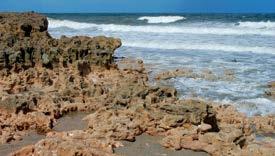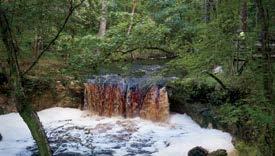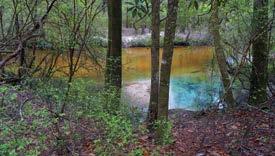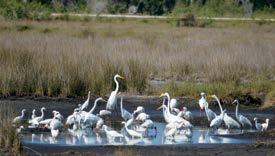
8 minute read
Unique Skilles Required A Lesson In Trail Maintenance in Big Cypress
Unique Skills Required
Jenna Taylor, South/Central Regional Program Manager
Advertisement
A volunteer stands on the trailer before departing for 7 Mile Camp in 2021.
A Lesson in Trail Maintenance in Big Cypress
Hiking in Big Cypress is unlike anywhere else along the Florida Trail, so it should be no surprise that maintaining Big Cypress is unlike anywhere else along the Florida Trail. Running a brushcutter becomes an entirely different experience when you are trying to keep it out of knee deep water. Utilizing a chainsaw is a lot harder when you have to hike the chainsaw, a tool kit, wedges, chaps, sawyer helmet and fuel out five miles to remove one tree and then hike it all back. Even lopping takes on a new artistic form as maintainers groom the cypress trees instead of adopting a “more is better” approach to thick areas. That’s why, when the three chapters responsible for the Big Cypress region of the trail approached the Florida Trail Association with their need for more skilled maintenance workers in their region, an idea began to form. The three chapters, Big Cypress, Alligator Amblers and the Happy Hoofers cover the Florida Trail from the Southern Terminus at Oasis Visitor’s Center to John Stretch Park at the bottom of Lake Okeechobee (maps 40-42) This stretch of trail includes six official campsites, three blue, a yellow and a red trails and endless wide open views of South Florida. Additionally, the chapters maintain other trails in their communities including the Fakahatchee Strand Preserve State Park and Collier Seminole State Park. These trails range wildly from dry hardwood hammocks to cypress swamps. Depending on the time of year, a hiker or maintainer can have an entirely different experience as they cross the Preserve. Footing along this section of trail can range from submerged, to shoe sucking marl and slippery mud, to firm footing. Typically, Big Cypress is maintained through several events led solely by the chapters or with the FTA team for support. These events are advertised on the FTA website and through the chapters individually. In November and December, the Happy Hoofers tackle the entire section north of I-75 to the levees south of Lake Okeechobee. Volunteers are able to access these work parties by their own vehicles and sometimes use those vehicles to get the work done on long stretches of trail on the levees.
In December, a Big Cypress Chapter work party based at Oasis Visitor’s Center covers the first 5 miles of the Florida Trail. This popular section gets a great deal of foot traffic and often sees many visitors from the general public on recreational hikes and guided tours. At the end of the 2022 season, we will have accurate statistics on just how many users this section gets thanks to a new trail counter near the first mile marker provided by the visitor usage study with the University of Florida. Work on the blue trail and Roberts Lake trail (the former southern terminus for the Florida Trail ) begins during this time as well.
Then, in the Spring, the Big Cypress chapter takes on the section of trail between mile 5 and Oak Hill Campsite during two work parties. This backcountry experience requires the volunteer crew to take a swamp buggy in and be completely self-sufficient for 5 days. Frequently, volunteers have needed
Q: How large should a blaze be? A: 2 inches wide and 6 inches long (about the size of a dollar bill).
to hike in and out of this work party to free up space on the buggy.
Finally, the Alligator Amblers wrap up the trail maintenance season with a late Spring work party to maintain Oak Hill to I-75. This section tends to be the wettest and waiting a little longer can help maintainers to have a bit of firmer footing. They often have to work to eradicate poison ivy that has crept into their three campsites, Oak Hill, Thank God Island and, appropriately named, Ivy Camp.
The first Southern Trail Skills Regional Training took place the first weekend in November 2021 at the Everglades National Park Institute. Everglades National Park Institute is a unique partnership between Everglades National Park and an official nonprofit partner, Florida National Parks Association. The Institute provides immersive, educational experiences for visitors. Their facility allows groups who serve the region, to host events utilizing their bunkhouses, camping area and classrooms.
The class was offered to active members, volunteers and activity leaders within the three chapters. Friday evening opened with introductions and dinner. Then, we got right to work. Small groups, armed with the Florida Trail Association’s Trail Manual began hunting down the answers to trivia questions.
On Saturday morning, participants were split into two groups. One crew headed outdoors with Abe Christian, FTA’s Technical Advisor, for a hands-on tool maintenance and usage class. With safety and efficiency at the forefront of each tool presented, Abe shared the best practices for loppers, brush cutters, mowers and more. Everyone had the chance to practice what they were learning and spent time sharpening, cleaning and tuning up equipment.
Inside, representatives from each chapter shared about the sections they maintained in detail. Then they led participants through planning and promoting a work party to vetting, selecting and informing volunteers about service opportunities. Kay Ferrara and Richard Warren put on their acting hats and
Participants hunt in the Trail Manual.
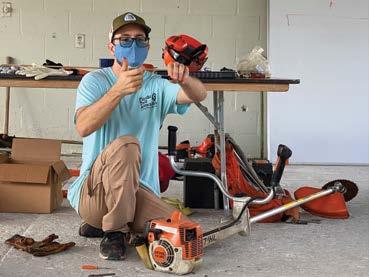
gave the group “volunteers” to consider. The class then discussed and voted to select or redirect for the maintenance opportunity presented. Finally, the paperwork and safety considerations were reviewed.
After lunch, participants swapped classes. While cooking dinner, we demonstrated and discussed best practices for a camp kitchen. To close out the eventful day, the group gathered around a campfire for another beautiful Big Cypress sunset.
Then, it was time to practice what they’d learned. Gathering after breakfast, all volunteers participated in a Tailgate Safety Briefing. Three crews were established. The first would be working with mowers and brushcutters along the airstrip at the beginning of the trail at Oasis Visitors Center. Since this section is a raised berm with distrubed soil, invasive species grow abundantly. Led by Abe, a crew took turns using all the equipment and discussing frequent problems that come up in the field and how to solve them.
The other two crews traveled to Gator Hook Trail off of Loop Road in the Preserve. This five mile trail offers a challenging hike but offers incredible views in exchange for your efforts. Logging took place in this section of the Preserve, and railroad ties from the logging trams are visible below the water.
Crews worked for several hours on this trail, confronted first with a half-mile trek through solution holes and deep water. Coached by the facilitators and each other, participants worked with a variety of tools including brushcutters, hand saws and loppers. New blazes shown in canary yellow throughout the trail and the entrance on Loop Road was cleared back to provide a more welcoming trailhead.
This training opportunity was a wonderful experience and now 40 volunteers from the region are ready to maintain it safely and efficiently. The three chapters in the region provided a great model for cooperation in the name of effectively meeting the goals of the Florida Trail Association. Many thanks to the leadership of the Big Cypress, Alligator Amblers and Happy Hoofer chapters whose vision created something that can be repeated and replicated around the state for years to come.
For more information on how to get involved maintaining the southern sections of the trail be sure to check out the Big Cypress, Alligator Ambler and Happy Hoofer pages on www.floridatrail.org or on their social media pages. As always, you can find more information about training opportunities like this one and volunteer opportunities throughout the state on the FTA website as well.

PHOTOS
33(Above) Richard Warren leads volunteer selection scenarios.
34 (Left)Jenna Taylor cooking dinner. Photo credit Susan Bennett Manns. 34 (Right)Volunteer Ayla cracks eggs for 40!
35(Top) A participant carries a brushcutter through deep water on Gator Hook Trail. 35(Bottom) Mower and brush cutting crew at Oasis Visitor’s Center.
36(Bottom) Debra Taylor and Mickey Miller from the Alligator Amblers.
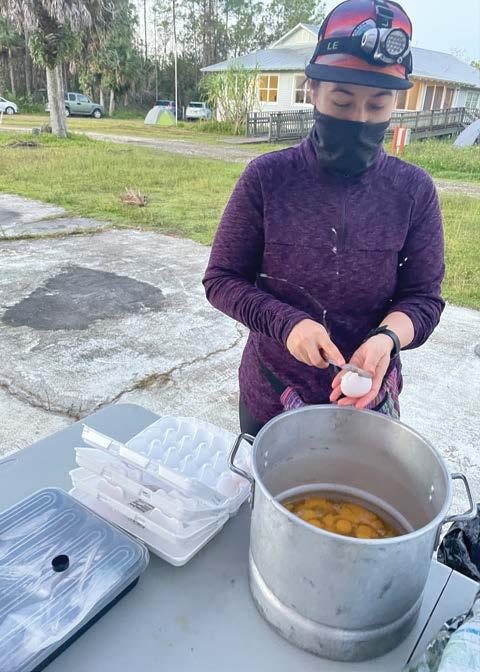
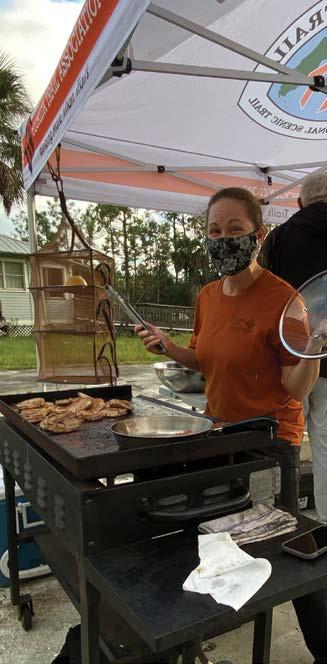
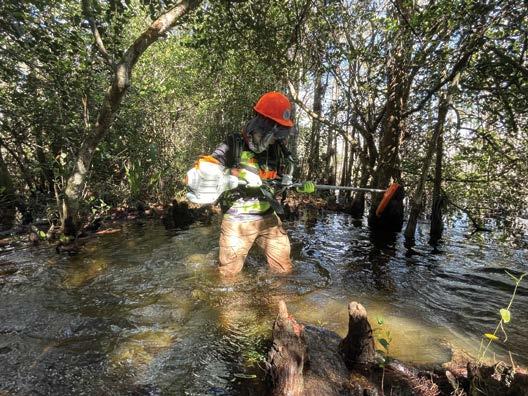
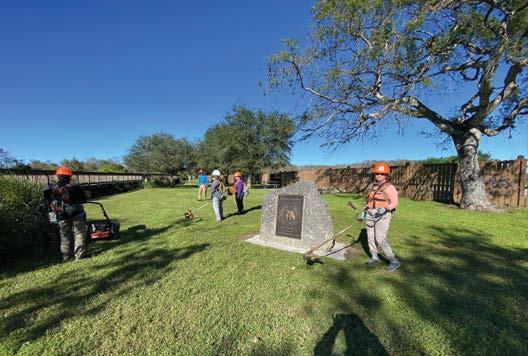
LOGGING IN BIG CYPRESS
LOGGING TOOK PLACE IN BIG CYPRESS IN THE LATE 1920S UNTIL THE LATE 1950S. ACCORDING TO THE NATIONAL PARK SERVICE, “WITH THE ADVENT OF POWER SAWS IN THE 1950S, THE LOGGING RATES INCREASED DRAMATICALLY. BETWEEN 1944 AND 1956, A SINGLE SAWMILL SHIPPED OUT 360 MILLION BOARD FEET OF CYPRESS LUMBER FROM THE BIG CYPRESS SWAMP.” THE PRESERVE WAS ESTABLISHED IN 1974 TO PROTECT THE REGION, BUT EVIDENCE OF THE LOGGING DAMAGE IS STILL APPARENT TODAY.
PHOTO CREDIT: UNIDENTIFIED MEN LOGGING CYPRESS IN THE EVERGLADES - EVERGLADES, FLORIDA . 1952-02. STATE ARCHIVES OF FLORIDA, FLORIDA MEMORY.
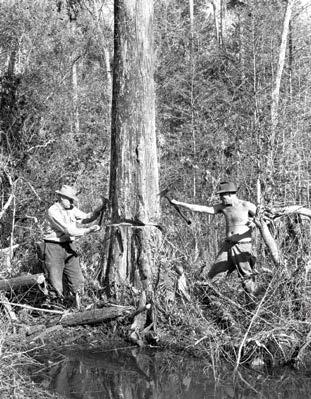
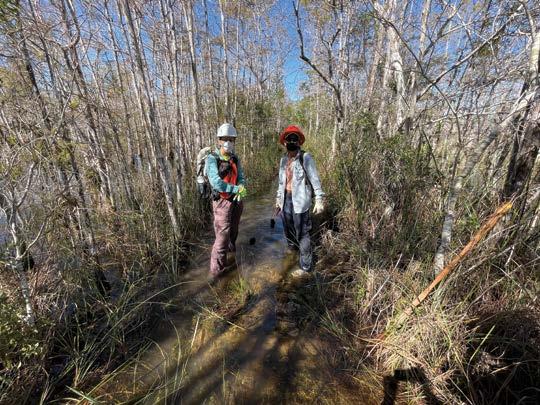
Revealed along its trails A footstep at a time A paddlestroke away A ride into the unknown: Florida, naturally.
Trail information, how-to, reviews, guidebooks & more
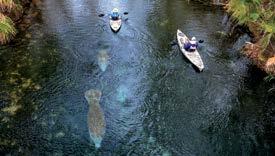


FloridaHikes.com
